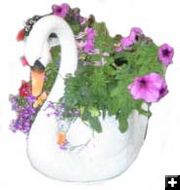
The next Sage and Snow Garden Club meeting will be May 19, 5:30 pm, in the Cooperative Extension Service Office at 621 South Pine, Pinedale. Come at 5 pm for social time.
|
|
Dig It! - Intensive Gardening - Part II
More Produce in Less Space
by Sage and Snow Garden Club
May 19, 2009
Part 1 of this series of articles on intensive gardening covered planning and soil preparation. The practice of intensive gardening is not just for those with limited garden space; rather, an intensive garden concentrates your work efforts to create an ideal plant environment, giving better yields. The intensive gardening ideal is to have something growing in every part of the garden at all times during the growing season.. An intensive garden minimizes wasted space. This article covers interplanting and future articles will discuss vertical gardening, succession planting, and relay planting.
Growing two or more types of vegetables in the same place at the same time is known as interplanting. Proper planning is essential to obtain high production and maintain the quality of the crops you planted. This technique has been practiced for thousands of years, but is just now gaining widespread support in this country. To successfully plan an interplanted garden you must take into account several factors for each plant: the length of its growth period, its growth pattern (tall, short, below or above ground), possible negative effects on other plants (such as the allelopathic effects of sunflowers and Jerusalem artichokes on nearby plants), preferred season, and light, nutrient, and moisture requirements. You can accomplish interplanting by alternating rows within a bed (plant a row of peppers next to a row of onions), by mixing plants within a row, or by distributing various species throughout the bed. For the beginner, alternating rows may be the easiest to manage.
Long-season (slow-maturing) and short-season (quick-maturing) plants like carrots and radishes, respectively, can be planted at the same time. The radishes are harvested before they begin to crowd the carrots. An example of combining growth patterns is planting smaller plants close to larger plants, (radishes at the base of beans or broccoli). Shade tolerant species like lettuce, spinach, and celery may be planted in the shadow of taller crops. Heavy feeders, such as cabbage family crops, should be mixed with less gluttonous plants. Root, leaf, and soil-building crops (legumes) may be mixed to take advantage of available nutrients.
Interplanting can help keep insect and disease problems under control. Pests are fairly crop-specific; that is, they prefer vegetables of one type or family. Mixing families of plants avoids large expanses of the pest-preferred crop, helping to contain early pest damage within a small area, giving you a little more time to deal with the problem. One disadvantage is that when it does come time to spray for pests, itís harder to be sure that all plants are protected.
Individual plants are more closely spaced in a raised bed or interplanted garden. An equidistant spacing pattern calls for plants to be the same distance from each other within the bed; that is, plant so that the center of one plant is the same distance from the centers of plants on all sides of it. In beds of more than two rows this means that the rows should be staggered so that the plants in every other row are between the plants in the adjacent rows. The distance recommended for plants within the row on a seed packet is the distance from the center of one plant to the center of the next. This results in a more efficient use of space and leaves less area to weed and mulch. The close spacing tends to create a nearly solid leaf canopy, acting as a living mulch, decreasing water loss, and keeping weed problems down. However, plants should not be crowded to the point at which disease or pest (such as slug) problems arise or competition causes stunting.
The next Sage and Snow Garden Club meeting will be May 19, 5:30 pm, in the Cooperative Extension Service Office at 621 South Pine, Pinedale. Come at 5 pm for social time. Contact us at Box 2280, Pinedale, WY, 82941, by email at sageandsnow@yahoo.com or call 307-859-8606.
|
